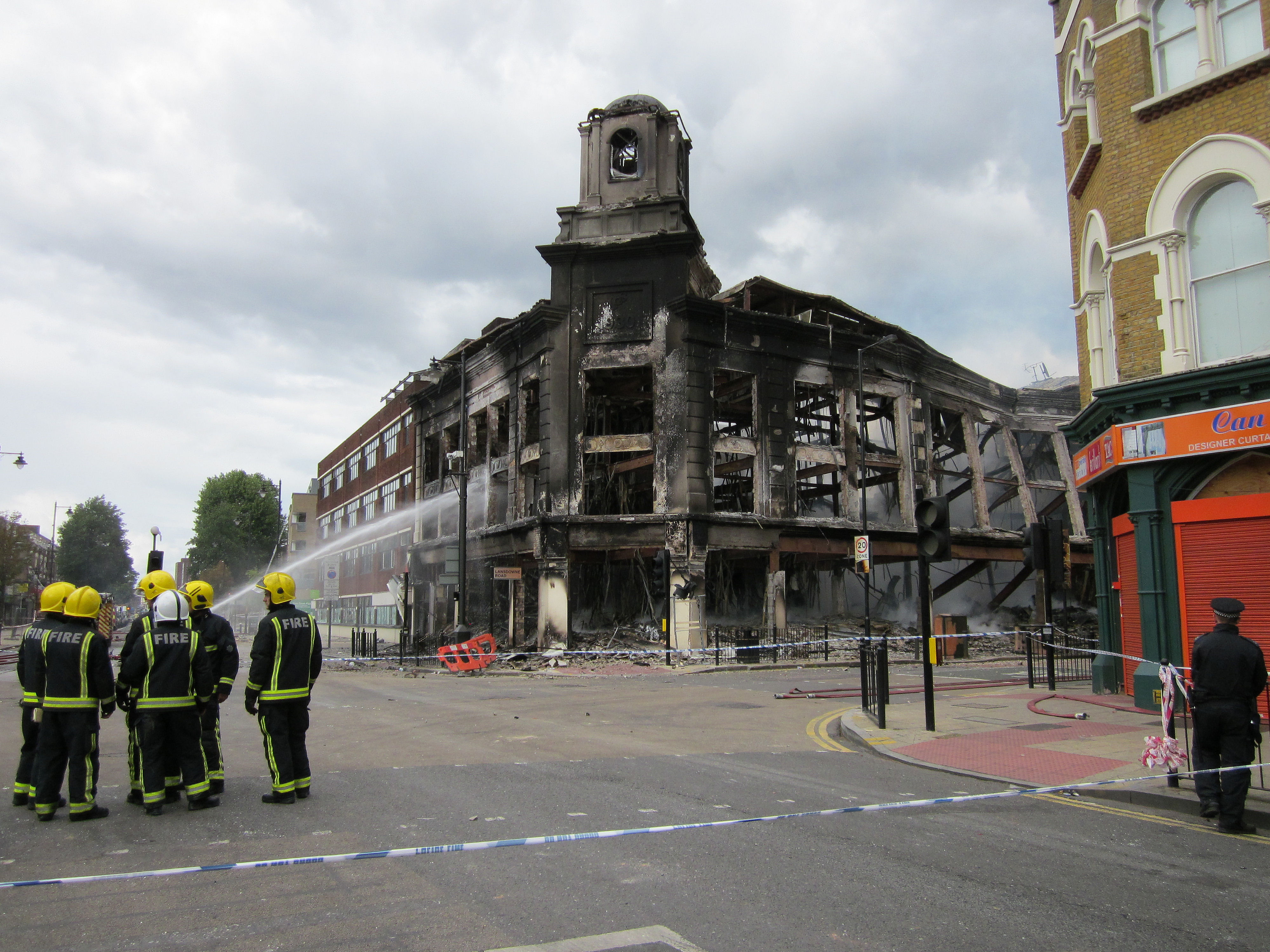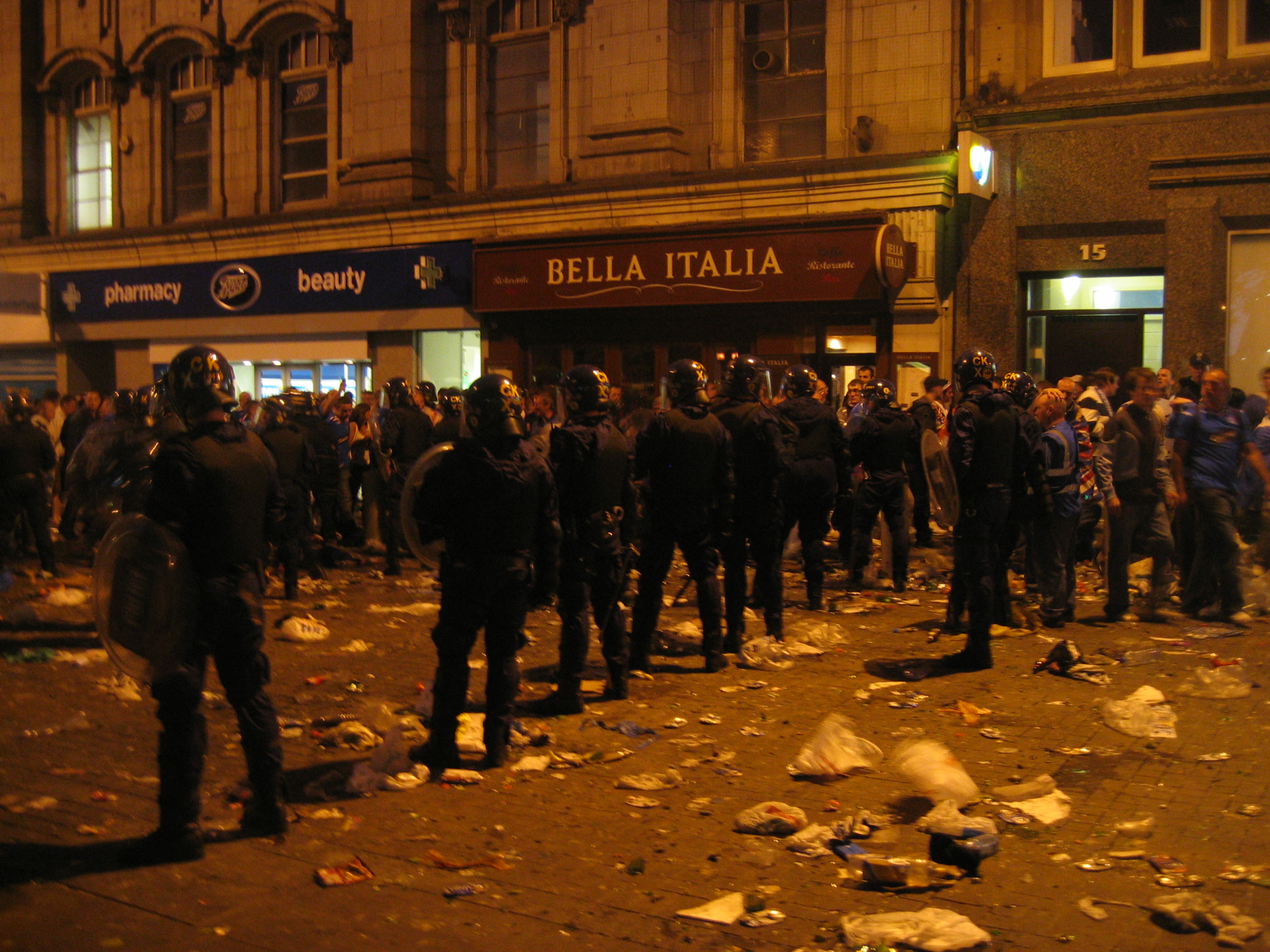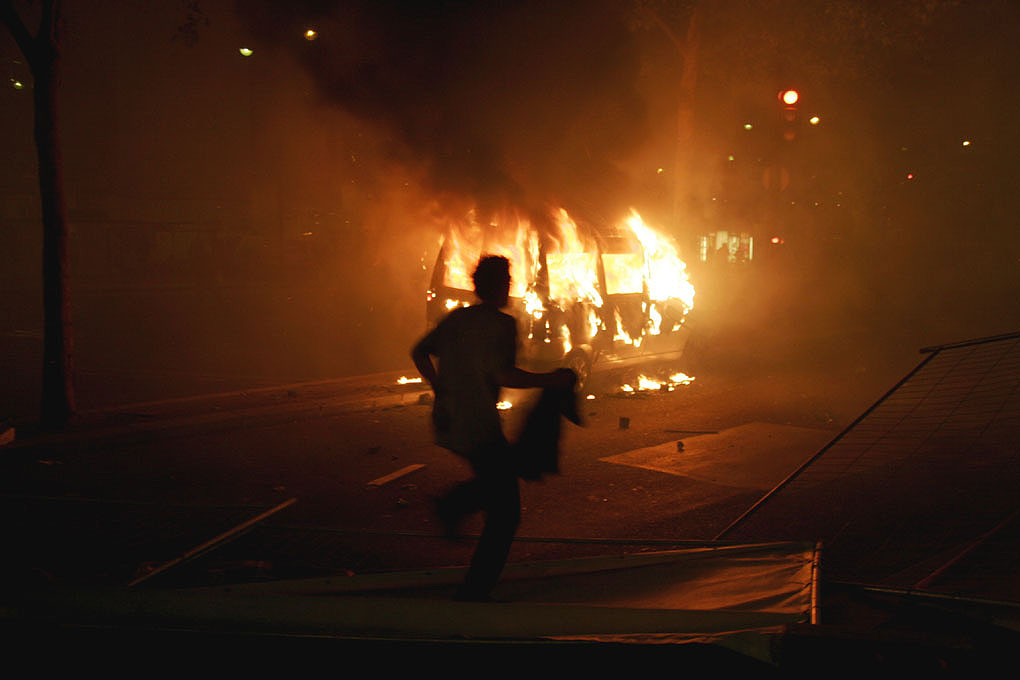Difference between revisions of "Security issue: Destruction by riots"
| (5 intermediate revisions by 2 users not shown) | |||
| Line 1: | Line 1: | ||
[[Category:Threat]][[Category:Safety]] |
[[Category:Threat]][[Category:Safety]] |
||
'''Destruction by riots''' is the act of [[ |
[[Image:Carpetright store after Tottenham riots.jpg|thumb|right|300px|Firefighters douse a shop and flats destroyed by arson during the initial rioting in 2011 in Tottenham, London]]'''Destruction by riots''' is the act of [[Security issue: Vandalism|vandalism]] of property by groups for a shared rational or rationalised reason. |
||
== Description == |
== Description == |
||
Riots are physical expressions of discontent by large unorganised groups of people, expressed in vandalism, assault and/or pillaging. Although the riot may be unorganised, the reason for these people being there may well have a collectively shared motivation. Based on their nascency, three types of riots can be distinguished: |
Riots are physical expressions of discontent by large, mostly unorganised groups of people, expressed in vandalism, assault and/or pillaging. Although the riot may be unorganised, the reason for these people being there may well have a collectively shared motivation. Based on their nascency, three types of riots can be distinguished: |
||
=== Organised protests === |
=== Organised protests === |
||
Sometimes peaceful, organised protests can quickly turn into unorganised and destructive riots. Examples of such events are the [[Wikipedia:2011 England riots|2011 events in Tottenham, London]]<ref>see: http://www.guardian.co.uk/uk/2011/aug/07/tottenham-riots-peaceful-protest</ref> and the riots in Rome in October 2011<ref>see: http://www.italymag.co.uk/italy/riot/peaceful-protest-dissolves-riots-rome</ref>. In these cases the protest, especially when arousing stormy emotions, can turn into a riot when external circumstances provoke strong and emotional responses. |
|||
=== Events === |
=== Events === |
||
| Line 45: | Line 45: | ||
Riots lead to considerable costs in both a direct ([[Economic effects of crime#Primary economic impact of crime|primary]]) and a indirect ([[Economic effects of crime#Secondary economic impact of crime|secondary]]) way<ref>Primary economic impact (or direct effects) are generally defined as the initial, immediate economic output generated by a specific cause (in this case a criminal offence). Secondary economic impact (or indirect effects) are generated each time a subsequent transaction is made, for example, the impact of crime on the real estate value in the neighbourhood.</ref>. Direct costs of destruction by riots come in the form of: |
Riots lead to considerable costs in both a direct ([[Economic effects of crime#Primary economic impact of crime|primary]]) and a indirect ([[Economic effects of crime#Secondary economic impact of crime|secondary]]) way<ref>Primary economic impact (or direct effects) are generally defined as the initial, immediate economic output generated by a specific cause (in this case a criminal offence). Secondary economic impact (or indirect effects) are generated each time a subsequent transaction is made, for example, the impact of crime on the real estate value in the neighbourhood.</ref>. Direct costs of destruction by riots come in the form of: |
||
* Preventive costs in anticipation of riots (e.g. security measures, insurance); |
* Preventive costs in anticipation of riots (e.g. security measures, insurance); |
||
* Material and immaterial costs as a consequence of rioting (e.g. physical damage, repairs, medical costs, mental harm)<ref>For example: In 2005 the civil unrest in France lasted for over three weeks and spread to nearly 300 towns. By the end of the incident, over 10,000 vehicles were destroyed, over 300 buildings burned, 126 police and |
* Material and immaterial costs as a consequence of rioting (e.g. physical damage, repairs, medical costs, mental harm)<ref>For example: In 2005 the civil unrest in France lasted for over three weeks and spread to nearly 300 towns. By the end of the incident, over 10,000 vehicles were destroyed, over 300 buildings burned, 126 police and firefighters were injured, and damages were estimated at being well over €200 Million (Source: Wikipedia. Online:http://en.wikipedia.org/wiki/Riot#Effects).</ref>; and |
||
* Responsive costs to riots (e.g. the costs of detection and prevention, prosecution, support trial, etc.). |
* Responsive costs to riots (e.g. the costs of detection and prevention, prosecution, support trial, etc.). |
||
| Line 52: | Line 52: | ||
* Rioting also has a distinct impact on tourism. "China reported that disturbances in Xinjiang in 2009 led almost 85,000 travellers to cancel trips to the area, while Thailand has seen a big drop in tourism since its political troubles turned violent"<ref>http://www.investopedia.com/financial-edge/1210/how-riots-influence-an-economy.aspx#axzz2Dd7xpsbL</ref> in the spring of 2010. |
* Rioting also has a distinct impact on tourism. "China reported that disturbances in Xinjiang in 2009 led almost 85,000 travellers to cancel trips to the area, while Thailand has seen a big drop in tourism since its political troubles turned violent"<ref>http://www.investopedia.com/financial-edge/1210/how-riots-influence-an-economy.aspx#axzz2Dd7xpsbL</ref> in the spring of 2010. |
||
In theory, security measures can prevent destruction by riots, but not without [[Economic effects of anti-crime security measures|costs]]. Target hardening or access control, for example, is costly and there is always the risk of [[The economics of crime#Crime displacement|crime displacement]]<ref>The relocation of crime from one place, time, target, offence, or tactic to another as a result of some crime prevention initiative |
In theory, security measures can prevent destruction by riots, but not without [[Economic effects of anti-crime security measures|costs]]. Target hardening or access control, for example, is costly and there is always the risk of [[The economics of crime#Crime displacement|crime displacement]]<ref>The relocation of crime from one place, time, target, offence, or tactic to another as a result of some crime prevention initiative. Source: Guerette (2009): Analyzing Crime Displacement and Diffusion. Tool Guide No. 10.</ref>. |
||
Crime is closely related to poverty, social exclusion, wage and income inequality, cultural and family background, level of education and other economic and social factors<ref>Buananno, P. (2003) |
Crime is closely related to poverty, social exclusion, wage and income inequality, cultural and family background, level of education and other economic and social factors<ref>Buananno, P. (2003): The Socio-economic Determinants of Crime. A Review of the Literature. Working Paper Series, No.63. University of Milan.</ref>. With the help of [[Economic tools|economic tools]] such as [[Social cost-benefit analysis|social cost-benefit analysis]] it is possible to overview the costs and future benefits of security measures in order to decide which types of measures are best suited for a specific urban planning situation. |
||
===Mobility impact=== |
===Mobility impact=== |
||
Latest revision as of 23:15, 19 January 2018
Destruction by riots is the act of vandalism of property by groups for a shared rational or rationalised reason.
Contents
Description
Riots are physical expressions of discontent by large, mostly unorganised groups of people, expressed in vandalism, assault and/or pillaging. Although the riot may be unorganised, the reason for these people being there may well have a collectively shared motivation. Based on their nascency, three types of riots can be distinguished:
Organised protests
Sometimes peaceful, organised protests can quickly turn into unorganised and destructive riots. Examples of such events are the 2011 events in Tottenham, London[1] and the riots in Rome in October 2011[2]. In these cases the protest, especially when arousing stormy emotions, can turn into a riot when external circumstances provoke strong and emotional responses.
Events
Events which arouse strong emotions, especially when aggravated by a strong sense of competition or the use of alcohol, can disinhibit natural restraint and lead to group processes that can lead to excessive violence. The sport of football has a long history of riots associated with it[3]. These kinds of riots are often associated with a group of agitators, known as hooligans, who instigate such violent actions.
Social unrest
Felt social wrongs can build a common frustration that can release itself in sometimes very violent and wide-spread riots. The 2005 Paris civil unrest, which resulted in a three-month declaration of the state of emergency[4].
Contributing circumstances
Known circumstances to influence the likelihood or effect of destruction by riots, are presented in the table below:
| Contributing Circumstance | Influence | Description |
|---|---|---|
| Use of alcohol | Decreases inhibitions. | The initial response of alcohol may be calming, but once an aggressive trigger is present, people who have been drinking are quicker to respond in violent ways[5]. |
| Excitement and competition | Increases likelihood of emotional response. | Aggressive behaviours are more likely to occur after aggressive games[5]. |
| Previous acts of riot/Tradition of riots (f.e. annual) | Increases probability of riots | A tradition of rioting can set the stage for new riots breaking out. |
| Long reaction times or inadequate action of intervention force | Decreases likelihood of apprehension. | Intervening in an 'explosive' emotional situation is very tricky; the wrong response can easily trigger an adverse effect and worsen the situation. Providing support for intervention forces allowing them to react before an explosive situation arises is therefore very important. |
| High levels of unemployment | Increases likelihood social unrest. | High levels of unemployment decrease social stability which can act as an agent for riots to develop. |
| Presence of high levels of crime | Increases probability of riots. | Street riots commonly occur in places where crime is a serious and chronic problem[5]. |
| Presence of crowds | Decreases likelihood of apprehension. | It has been argued that large crowds cause individuals to act aggressively and without restraint because they confer anonymity[6]. Furthermore, The impact of the crowd includes “deindividuation,” in which there is a mob mentality and people no longer act as individuals but rather as a group. People do things in this state that they would not otherwise do[5]. |
| Presence of protest demonstrations | Increases likelihood of riots forming. | In areas where protest demonstrations are regularly held, the likelihood of one such demonstration turning into a riot is always present. |
Impacts
Social impact
Destruction by riots can have social impact such as increase in citizens' perception of insecurity, fear of crime, and avoiding of the places of the riots. This can result in urban space becoming increasingly more attractive for rioters, with a chain of increasing destruction.
Economic impact
Riots lead to considerable costs in both a direct (primary) and a indirect (secondary) way[7]. Direct costs of destruction by riots come in the form of:
- Preventive costs in anticipation of riots (e.g. security measures, insurance);
- Material and immaterial costs as a consequence of rioting (e.g. physical damage, repairs, medical costs, mental harm)[8]; and
- Responsive costs to riots (e.g. the costs of detection and prevention, prosecution, support trial, etc.).
In addition, the secondary economic impact of crime has to be considered:
- Riots make investors nervous: "Although the Thai stock market has recovered strongly this year, investors saw a 10% drop while the rioting was going on (in 2010)[9]. "Moreover, while Thailand no doubt benefited from its reputation as a peaceful and relatively orderly country, countries with chronic troubles risk getting labelled as "basket cases" and virtually eliminated from serious consideration as investment destinations"[9].
- Rioting also has a distinct impact on tourism. "China reported that disturbances in Xinjiang in 2009 led almost 85,000 travellers to cancel trips to the area, while Thailand has seen a big drop in tourism since its political troubles turned violent"[10] in the spring of 2010.
In theory, security measures can prevent destruction by riots, but not without costs. Target hardening or access control, for example, is costly and there is always the risk of crime displacement[11]. Crime is closely related to poverty, social exclusion, wage and income inequality, cultural and family background, level of education and other economic and social factors[12]. With the help of economic tools such as social cost-benefit analysis it is possible to overview the costs and future benefits of security measures in order to decide which types of measures are best suited for a specific urban planning situation.
Mobility impact
Since riots take place at Open and civic spaces, the mobility function of those areas might be seriously hampered. Accessibility might be reduced when, for example, roads are blocked. Also safety of vulnerable road users might be reduced, especially when important bicycle lanes or pedestrian paths are crossing the riot location.
With traffic management measures one can attempt to concentrate the riot at a location with little impact on mobility and to reduce the negative consequences for mobility, for example by rerouting traffic around the riot location.
Access control can ensure only flows of the intended people enter or exit the area and can enforce and intended separation of crowds.
Also by directing traffic flows (including flows of people), the crowd and traffic flows can be controlled.
Safety impact
Riots can do massive physical and/or bodily damage, as shown by the examples above. A rioting crowd has very little attention for the consequences of their actions. This is why one of the first measures taken if a riot is already broken out, is to isolate it to limit the damage.
Measures
Potential measures that can mitigate the likelihood or impact of destruction by riots include:
- Target hardening to ensure violence cannot overcome other measures taken (such as directing traffic flows or access control), can prevent a riot getting out of hand.
- Surveillance may have some effect on deindividuation if spectators know they are there.[5]
- Intervention force is needed to make detection measures, such as alarms or surveillance, effective.
- Directing traffic flows can be effective in reducing the chance for potential rioter to approach vulnerable areas or opponents. By providing clear and logical access and exit routes and/or transportation through an area, unnecessary provocation can be avoided. Also one could consider levels of permeability if it would facilitate natural crowd dispersion
- Removing means can contribute to a more secure environment by making sure any materials that might be helpful for riots are unavailable, e.g. by designing a road in asphalt instead of throwable bricks.
- Avoid long stretches of blank walls where the space is located near a public throughway. Where this cannot be avoided access to buildings / blank walls should be made difficult through the planting of trees, bushes or shrubs.
- Controlling disinhibitors such as alcohol can directly decrease the problem. A careful design with compatible land uses and activities is important.
- Removal of crime motivator can sometimes be effected by moving a riot-prone activity to a less vulnerable area.
- Access control can ensure only flows of the intended people enter or exit the area and can enforce and intended separation of crowds.
- Screening can sometimes be applied (for examples at stadiums at high-risk matches) to ensure the nature of the visitors, such as scanning for a restraining order or for the presence of forbidden materials, such as fireworks or weapons.
Footnotes and references
- ↑ see: http://www.guardian.co.uk/uk/2011/aug/07/tottenham-riots-peaceful-protest
- ↑ see: http://www.italymag.co.uk/italy/riot/peaceful-protest-dissolves-riots-rome
- ↑ see: wikipedia:Football hooliganism
- ↑ see: wikipedia:2005 civil unrest in France
- ↑ 5.0 5.1 5.2 5.3 5.4 U.S. Department of Education’s, Report of the Proceedings, National Conference Addressing Issues Related to Celebratory Riots, November 20–21, 2003
- ↑ Weatherburn Don, Riots, Policing and Social Disadvantage: Learning from the Riots in Macquarie Fields and Redfern, Current Issues in Criminal Justice Volume 18 Number 1, July 2006
- ↑ Primary economic impact (or direct effects) are generally defined as the initial, immediate economic output generated by a specific cause (in this case a criminal offence). Secondary economic impact (or indirect effects) are generated each time a subsequent transaction is made, for example, the impact of crime on the real estate value in the neighbourhood.
- ↑ For example: In 2005 the civil unrest in France lasted for over three weeks and spread to nearly 300 towns. By the end of the incident, over 10,000 vehicles were destroyed, over 300 buildings burned, 126 police and firefighters were injured, and damages were estimated at being well over €200 Million (Source: Wikipedia. Online:http://en.wikipedia.org/wiki/Riot#Effects).
- ↑ 9.0 9.1 Investopedia, http://www.investopedia.com/financial-edge/1210/how-riots-influence-an-economy.aspx#axzz2Dd7xpsbL
- ↑ http://www.investopedia.com/financial-edge/1210/how-riots-influence-an-economy.aspx#axzz2Dd7xpsbL
- ↑ The relocation of crime from one place, time, target, offence, or tactic to another as a result of some crime prevention initiative. Source: Guerette (2009): Analyzing Crime Displacement and Diffusion. Tool Guide No. 10.
- ↑ Buananno, P. (2003): The Socio-economic Determinants of Crime. A Review of the Literature. Working Paper Series, No.63. University of Milan.


